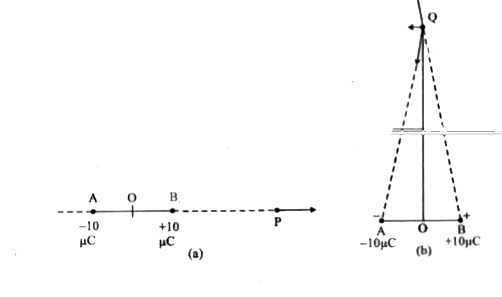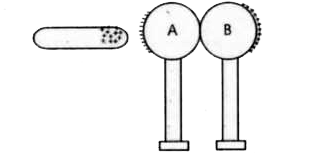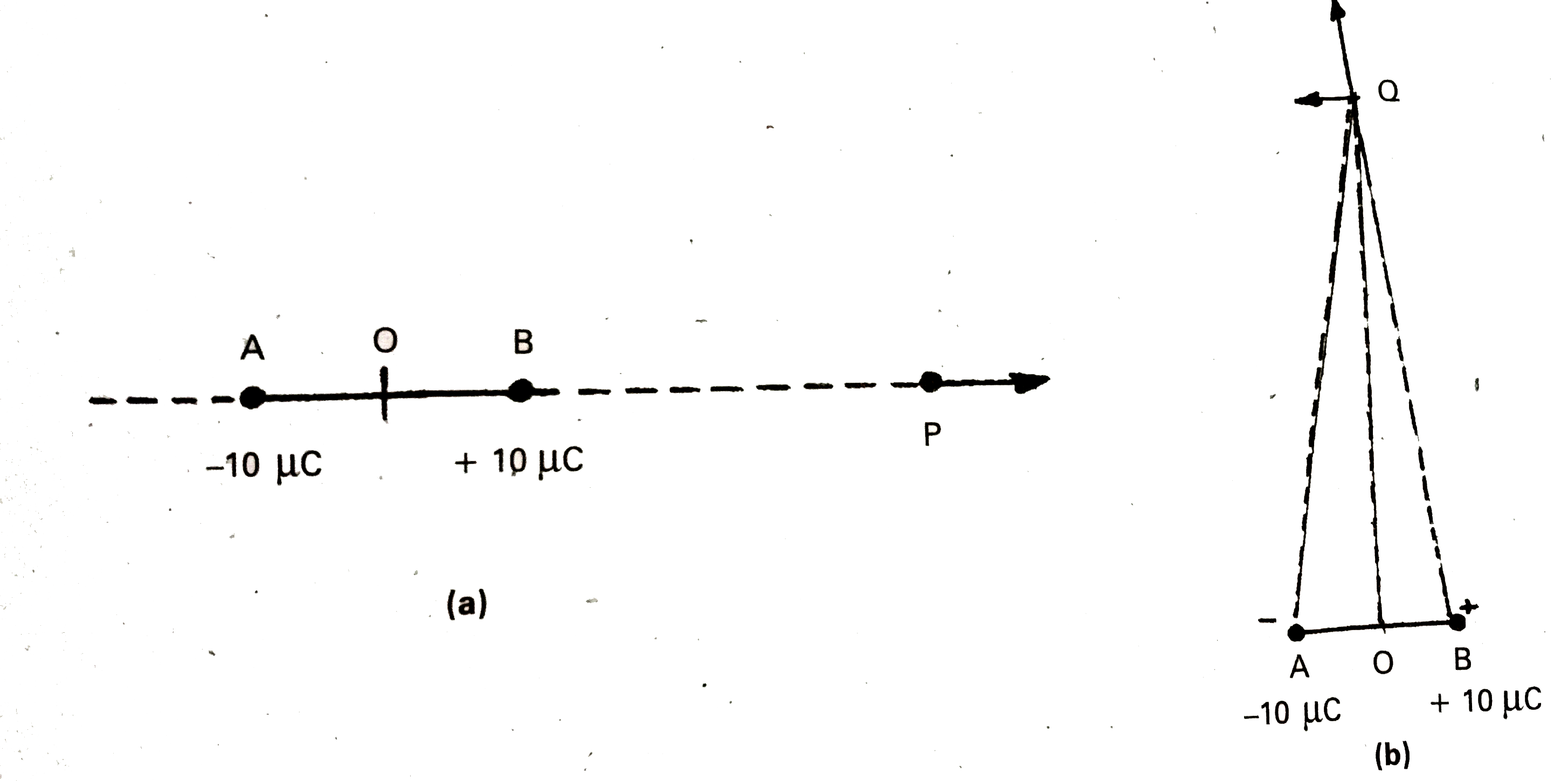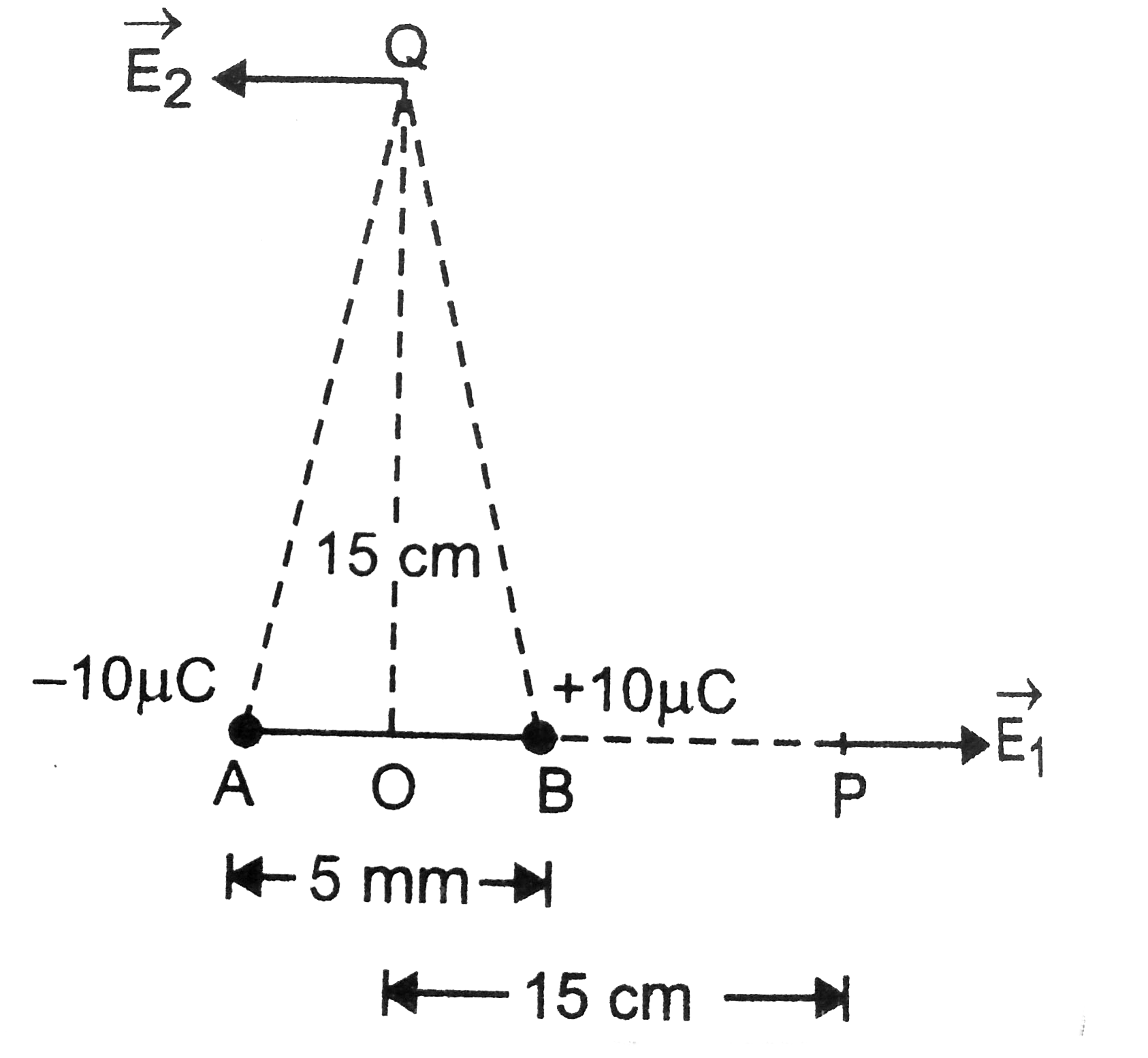Two charges ±10μC are placed 5.0 mm apart. Determine the electric field at (a) a point P on the axis of the dipole 15 cm away from its centre O on the side of the positive charges, as shown in Fig. (a) and (b) be a point Q, 15 cm away from O on a line passing through O and normal to the axis of the dipole, as shown in Fig (b).  Solution in Tamil
Solution in Tamil
Field at P due to charge +10μC=10−54π(8.854×10−12)×1(15−0.25)2×10−4
=4.13×106NC−1 along BP
Field at P due to charge −10μC=10−54π(8.854×10−12)×1(15+0.25)2×10−4
The resultant electric field P due to the two charges at A and B is =2.7×105NC−1 along BP. In this example, the ratio OP/OB is quite large (= 60). Thus, we can expect to get approximately the same result as above by directly using the formula for electric field at a far-away point on the axis of a dipole.
For a dipole consisting of charges ±q, 2a distance apart, the electric field at a distance r from the centre on the axis of the dipole has a magnitude E=2p4πε0r3 when r>>a
where p=2a q is the magnitude of the dipole moment.
The direction of electric field on the dipole axis is always along the direction of the dipole moment vector (i.e., from -q to q). Here, p=10−5×5×10−3=5×10−8Cm
Therefore E=2×5×10−84π(8.854×10−12)×1(15)2×10−6=2.6×105NC−1
along the dipole moment direction AB, which is close to the result obtained earlier.
Field at Q due to charge +10μC at B =10−54π(8.851×10−12)×1[152+(0.25)2]×10−4
Field at Q due to charge −10μC at A=10−54π(8.854×10−12)×1[152+(0.25)2]×10−4
=3.99×106NC−1 along QA.
Clearly, the components of these two forces with equal magnitudes cancel along the direction OQ but add up along the direction parallel to BA. Therefore, the resultant electric field at due to the two charges at A and B is =2×0.25√152+(0.25)2×3.99×106 along BA=1.33×105NC−1 along BA.
As in (a), we can expect to get approximately the same result using the formula for dipole field at a point on the normal to the axis of the dipole.
When r>>a,E=p4πε0r3=5×10−84π(8.854×10−12)×1(15)3×10−8=1.33×105NC−1
The direction of electric field in this case in opposite to the direction of the dipole moment vector.
Topper's Solved these Questions
- BOOK - NEW JOYTHI PUBLICATIONCHAPTER - ELECTRIC CHARGES AND FIELDS EXERCISE - Solution To Exercises From NCERT Text26videos
ELECTRIC CHARGES AND FIELDS
- BOOK - NEW JOYTHI PUBLICATIONCHAPTER - ELECTRIC CHARGES AND FIELDS EXERCISE - Evaluation Questions And Answers12videos
ELECTRIC CHARGES AND FIELDS
- BOOK - NEW JOYTHI PUBLICATIONCHAPTER - DUAL NATURE OF RADIATION AND MATTER EXERCISE - COMPETITIVE EXAM CORNER15videos
DUAL NATURE OF RADIATION AND MATTER
- BOOK - NEW JOYTHI PUBLICATIONCHAPTER - ELECTROMAGNETIC INDUCTION EXERCISE - COMPETITIVE EXAM CORNER13videos
ELECTROMAGNETIC INDUCTION
Similar Questions
What is the force between two small charged spheres having charges of 2×10−7Cand3×10−7C placed 30 cm apart in air?
03:06View SolutionA glass rod rubbed with silk is brought close to two uncharged spheres in contact with each other inducing charges on them as shown in figure.
a. What happens when the spheres are slightly separated.
b. the glass rod is subsequently removed.
c. the spheres are separated far apart. 03:45View Solution
03:45View SolutionIf 'm' is the mass of an electron and 'c' is the speed of light, the ratio of the wavelength of a photon of energy E to that of the electron of the same energy is
08:25View SolutionA 50 Hz ac current of peak value 2 A flows through one of the pair of coils. If the mutual inductance between the pair of coils is 150 mH, then the peak value of voltage induced in the second coil is
04:48View SolutionTwo charges +- 10 mu C are placed 5*0 mm apart. Determine the electric field at (a) point P on the axis of dipole 15 cm away from its center on the side of the positive charge. As shown in Figure and at (b) a point Q. 15 cm away form O on a line passing through O and a line passing through O and normal to the axis of the dipole as shown in Fig.
05:01View SolutionTwo charges +20muC and -20muC are placed 10mm apart. The electric field at point P, on the axis of the dipole 10 cm away from its centre O on the side of the positive charge is
03:06View Solution±10μc के दो आवेश एक - दूसरे से 5.0 mm की दुरी पर स्थित हैं । (a ) इस द्विध्रुव के अक्ष पर द्विध्रुव के केंद्र O से चित्र (a ) में दर्शायें अनुसार , धनावेश की और 15 सेमी दुरी पर स्थित किसी बिंदु p पर तथा (b ) द्विध्रुव के अक्ष के अभिलंबवत O से चित्र (b ) के अनुसार गुजरने वाली रेखा से 15 सेमी दुरी पर स्थित किसी बिंदु Q पर विद्युत - क्षेत्र का मान ज्ञात कीजिए ।
 View Solution
View SolutionTwo charges 10μC are placed 5.0 mm apart. Determine the electric field at a point P on the axis of the dipole 15 cm away from its centre O on the side of the positive charge, as shown in Fig.
 08:35View Solution
08:35View SolutionTwo charges 10 muC are placed 5.0 mm apart. Determine the electric field at a point Q, 15 cm away from O on a line passing through O and normal to the axis of the dipole, as shown in Fig.
02:59View SolutionTwo charges ±10μC are placed 5⋅0mm apart. Determine the electric field at (a) point P on the axis of dipole 15cm away from its center on the side of the positive charge. As shown in Figure and at (b) a point Q. 15cm away form O on a line passing through O and a line passing through O and normal to the axis of the dipole as shown in Fig.
 02:44View Solution
02:44View SolutionTow charges pm10 mu C are placed 5.0 mm apart determine the electric field at (a) a point p on the axis of the dipole 15 cm away from its centre o ont the side of the positive charge as (a) and (b) a point q 15 cm away from o on a line passing through o and normal to the axis of the dipole as
03:02View SolutionTow charges pm10 mu C are placed 5.0 mm apart determine the electric field at (a) a point p on the axis of the dipole 15 cm away from its centre o ont the side of the positive charge as (a) and (b) a point q 15 cm away from o on a line passing through o and normal to the axis of the dipole as
02:16View SolutionTwo charges ±10μC are placed 5⋅0mm apart. Determine the electric field at (a) point P on the axis of dipole 15cm away from its center on the side of the positive charge. As shown in Figure and at (b) a point Q. 15cm away form O on a line passing through O and a line passing through O and normal to the axis of the dipole as shown in Fig.
 02:57View Solution
02:57View SolutionTwo charges of dipole +- 10 mu C are placed 1mm apart. Determine the electric field at a point on the axis of the dipole 10 cm away from its centre and at 10 cm away from centre on the equator of the dipole.
02:41View SolutionTow charges ±10μ C are placed 5.0 mm apart determine the electric field at (a) a point p on the axis of the dipole 15 cm away from its centre o ont the side of the positive charge as (a) and (b) a point q 15 cm away from o on a line passing through o and normal to the axis of the dipole as
 03:52View Solution
03:52View Solution

